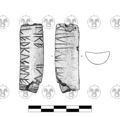SZ-22.2: Difference between revisions
No edit summary |
Sindy Kluge (talk | contribs) No edit summary |
||
| Line 9: | Line 9: | ||
|language=unknown | |language=unknown | ||
|meaning=unknown | |meaning=unknown | ||
|object=SZ-22 | |object=SZ-22 antler | ||
|position=inside | |position=inside | ||
|craftsmanship=engraved | |craftsmanship=engraved | ||
Revision as of 17:23, 1 March 2016
| Inscription | |
|---|---|
| Transliteration: | ? |
| Original script: | ? |
|
| |
| Object: | SZ-22 antler (antler) (Inscriptions: SZ-22.1, SZ-22.2) |
| Position: | inside |
| Script: | unknown |
| Direction of writing: | ambiguous |
| Number of lines: | 1 |
| Craftsmanship: | engraved |
| Current condition: | incomplete |
| Archaeological culture: | Late Iron Age [from object] |
| Date of inscription: | 5th–1st centuries BC [from object] |
| Date derived from: | cultural context [from object] |
|
| |
| Language: | unknown |
| Meaning: | unknown |
|
| |
| Alternative sigla: | PID 203 LIR SA-26 |
| Sources: | Schumacher 2004: 137 |
Images
|
Inscription SZ-22.2.
|
|
Commentary
First published in PID. Autopsied by TIR in November 2013.
Picture in LIR (drawing).
Length 4.4 cm. Read with the inscribed edge pointing downward ![]()
![]()
![]()
![]()
![]()
![]()
![]()
![]()
![]() ahua·huχl by Whatmough and, following him, Schumacher (alternatively
ahua·huχl by Whatmough and, following him, Schumacher (alternatively ![]()
![]()
![]()
![]()
![]()
![]()
![]()
![]()
![]() ahua·huχr) and Mancini (ahua·huφa). However, the fact that many of the scratches are joined to the lower ends of the hastae of the second line of SZ-22.1 suggests that they were executed by putting the tool into the existing indentations on the edge of the handle and scratching inward. The scratches being very long and of differing length, and becoming very thin towards the middle of the handle, corroborates this. Therefore, the inscription should be looked at the other way round. Its untidy appearance casts doubt on the scratches so far interpreted as the cross-bars of two characters read
ahua·huχr) and Mancini (ahua·huφa). However, the fact that many of the scratches are joined to the lower ends of the hastae of the second line of SZ-22.1 suggests that they were executed by putting the tool into the existing indentations on the edge of the handle and scratching inward. The scratches being very long and of differing length, and becoming very thin towards the middle of the handle, corroborates this. Therefore, the inscription should be looked at the other way round. Its untidy appearance casts doubt on the scratches so far interpreted as the cross-bars of two characters read ![]() or
or ![]() : they being much more slightly scratched than the others, and much longer than they'd need to be. What has been interpreted as some sort of punctuation mark is a vertical row of six very short horizontal scratches separating the inscription into two parts which may be argued to be intended as identical, excepting the
: they being much more slightly scratched than the others, and much longer than they'd need to be. What has been interpreted as some sort of punctuation mark is a vertical row of six very short horizontal scratches separating the inscription into two parts which may be argued to be intended as identical, excepting the ![]() to the very right. A grouping of the strokes into letters cannot be achieved with any certainty.
to the very right. A grouping of the strokes into letters cannot be achieved with any certainty.
Why an inscription should be applied to the inside of a handle where it could not be seen is a question closely related to that of whether the scratchings are script, or maybe non- or pseudo-script. An inscription may have been added after the handle was disjoined from the knife before being used as a votive offering, or even right after SZ-22.1 if the handle was never even part of an actual knife (see ??? for a discussion of bone and antler objects as articles of daily use or votives).
Further references: NRIE 99, Pisani 1935: 94, Battisti 1944: 230 f., Franz 1957: 107, Anm. 19, Zimmer et al. 1985: 166 (Nr 41).
Bibliography
| Battisti 1944 | Carlo Battisti, "Osservazioni sulla lingua delle iscrizioni nell'alfabeto etrusco settentrionale di Bolzano", Studi Etruschi 18 (1944), 199–236. |
|---|---|
| LIR | Alberto Mancini, Le Iscrizioni Retiche [= Quaderni del dipartimento di linguistica, Università degli studi di Firenze Studi 8–9], Padova: Unipress 2009–10. (2 volumes) |

